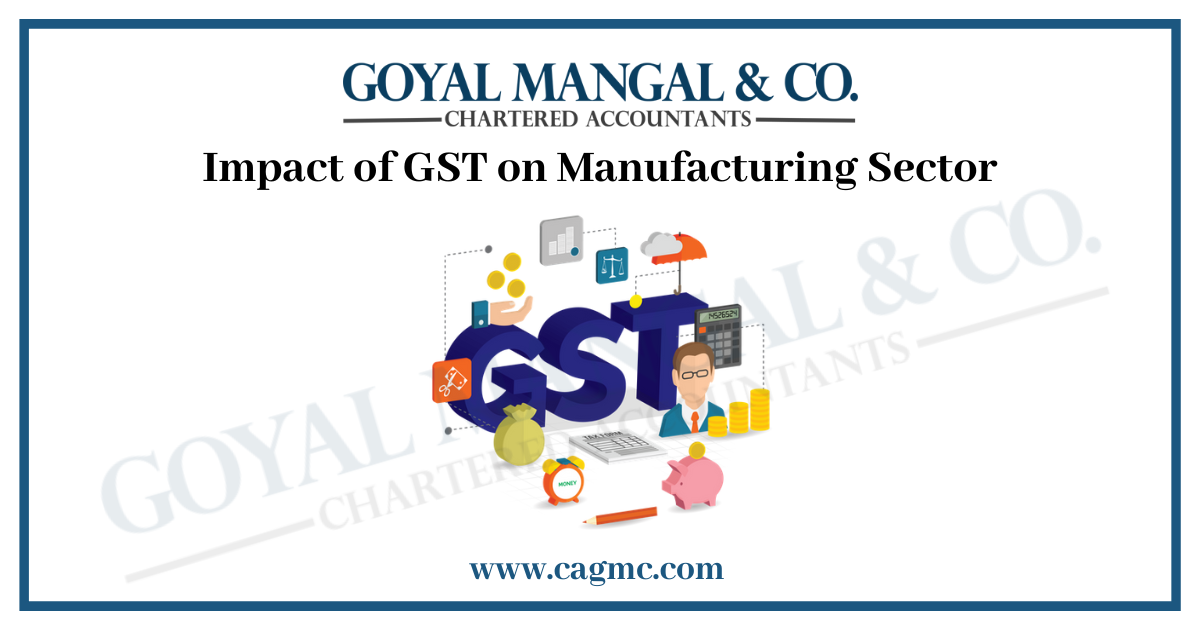
GST have considerably improved India’s manufacturing sector. Earlier the burden of complying with India’s complex indirect taxes system adds to manufacturing sector issues like falling exports and infrastructure spending. Multiple indirect tax regulations had increased compliance, administrative costs, categorization, value challenges, and overall business difficulty in this sector. Thus, a goods and services tax (GST) is essential for a struggling economy. This article discusses the impact of GST in the manufacturing sector and its potential challenges.
|
Table of Content |
Meaning of Manufacturing Industry
Manufacturing industries use either labour or machinery to manufacture goods from raw materials. It refines raw materials into metals, furniture, and processed foods. The manufacturing business is vast and intimately linked to engineering and industrial design.
Food, beverage, and tobacco product manufacturing, textile mills, textile product mills, apparel manufacturing, leather and allied product manufacturing, wood product manufacturing, non-metallic mineral product manufacturing, primary metal manufacturing, fabricated metal product manufacturing, machinery manufacturing, and computer and electronic product manufacturing are all subsectors of manufacturing.
Make in India Movement
The Make in India movement is a government-sponsored effort that aims to inspire businesses to design, produce, and assemble goods in India as well as to stimulate targeted investments in manufacturing. The campaign’s primary goal is to develop India as a hub for global design and manufacturing exports and to enhance the industrial sector there.
With the intention of accelerating the growth of the manufacturing sector, the campaign focuses on 25 economic sectors for the purpose of job creation and skill development. The Make in India program seeks to generate employment in the nation because there will be a greater need for workers as manufacturing companies expand.
Impact of GST in the Manufacturing Sector
The Goods and Services Tax (GST) in India has made manufacturing more competitive globally. The GST has lowered production costs, making Indian goods cheaper and more competitive. The GST has also streamlined logistics, making manufacturing more efficient. End-users benefit from cost reductions. The Make in India project, which aims to build India into a manufacturing and technological hub, is set to maximize the country’s demographic and geographic advantages.
GST also help in increasing manufacturing’s GDP share and eliminated the “tax-on-tax” regime, allowing producers to pay a single tax, increasing sales. The GST has reduced production costs and simplified taxes, making Indian industries more competitive globally. There aren’t that many drawbacks, but they’re significant in the grand scheme of things, and fixing them would do a lot to help manufacturers.
Positive impact of GST in the Manufacturing Sector
The positive impact of GST on Manufacturing Sector in India is:
- Reduced Production Costs: Cascading taxes like excise duty and VAT, which tax two different taxable events, caused manufacturers to pay 25-26% more for production. GST would tax one taxable event. Thus, items should become cheaper, helps in increasing sales and giving stakeholders a foothold in a competitive market.
- Simplification of Taxes: As GST pushes for transaction-based valuations as compared to excise duty, which was calculated using different methods like Specified duty, Tariff Value, Value based on Retail Sale price, and Ad Valorem duty, GST will be simplified and easier to calculate.
- Subsumed taxes lower prices and improve quality: Most inter-state supply taxes (central sales tax, OCTROI, entry tax, etc.) would now be creditable, easing the GST manufacturing sector’s burden and ensuring a stable credit flow. With most taxes being absorbed under the GST framework (excluding customs charge and Stamp charge, which will continue to be imposed), merchants and distributors would be able to obtain credit on the taxes levied, which will cut prices, a win-win situation. With indirect tax on manufacturers considerably decreased, the industry may focus more on quality rather than marketing, correcting quality gaps in a country sorely in need of an improvement in items produced.
- Supply chain restructuring improves corporate efficiency: State levies historically managed supply chains. GST’s “one-nation-one tax” concept will incentivize businesses to improve efficiency and operability by re-engineering their supply chains.
Without warehouses in separate states, manufacturing organizations can focus on economic, demographic, and geographic supply chain strategy. Inventory management and input tax credit benefits (mentioned above) will minimize storage costs, reduce checkpoint time, and strengthen manufacturing, which will instantly influence logistics.
- GST Registration limit: Previously, a manufacturer with many factories in one state had to register each factory separately. Under the GST framework, a taxable manufacturer with many factories in a state just needs one GST registration. This reduces paperwork and government intrusion at every stage, improving corporate management.
- Composition Scheme: Small manufacturing enterprises can now use the GST Composition Scheme (at 2%), delivering tax reduction to intended recipients. Of course, caveats apply to which manufacturing enterprises can and cannot opt for this program, along with documentary compliance and other requirements that consumption dealers must meet to apply for the same.
- No double-taxation: VAT, Service tax, Central Excise, sales tax, and others were assessed by different organizations. This difficult and time-consuming method exposed manufacturers to tax queries they couldn’t handle, harming their business. The impact of GST on business is positive. State authorities will now examine SGST, while Central authorities will analyse CGST and IGST. This would speed up the tax assessment process and assist producers avoid tax-related issues.
- Electronic filing: It reduces paperwork and complexity. Finally, GST on manufacturing is projected to reduce tax litigation in the tax administration and courts by classifying disputes under excessive calculation heads of the prior tax regime.
Other variables may affect MNC manufacturing enterprises and the industrial sector besides the GST. GST’s anti-profiteering clause requires producers to give end customers tax reduction/input tax credit benefits. This facilitates government-manufacturing cooperation.
Negative impact of GST in the Manufacturing Sector
This GST method has some drawbacks including:
- Due to advance, stock transfers (other than own depot and warehouse in same state due to same GSTIN), and branch transfers now taxed under GST, manufacturers will need more working capital.
- Petroleum items are excluded from GST, hence tax spent on them cannot be credited, so linked companies like power and logistics will continue to struggle with cost-benefit analysis.
- Reverse charge will now apply to goods as well as services. As a recipient-borne burden, these rising expenses will affect the manufacturing sector.
- CENVAT credit is only available on goods purchased from registered dealers (unregistered dealers must first pay tax by debiting Cash ledger before claiming ITC on it), which may not be feasible for small businesses.
- GST requires firms to revamp and streamline their transactions, which requires additional resources and money. From employing technical experts to establishing legal checks and balances, becoming GST-compliant can cost businesses that haven’t followed the rules.
- Since most firms do not comprehend GST, such as area-based exemptions (that enabled exclusions for select states like the North-East in case of threshold i.e., 10 lakhs but in other state it is 20 Lacs), operational and structural confusion is predicted to remain. This means a considerable shift in financial position of manufacturing companies who would now have to take stock of the situation and reassess their business strategy.
There aren’t that many drawbacks, but they’re significant in the grand scheme of things, and fixing them would do a lot to help manufacturers.
Takeaway
The manufacturing industry has a lot to gain from GST being implemented. The cost of manufactured goods in the hands of consumers benefits from the lowering of the cascading effect of taxes, particularly on the post-manufacture stage of the supply chain. However, there are still areas of concern, such as the 1% origin tax, the GST charged on stock transfers, and the higher prices caused by the exclusion of petroleum fuels from the GST’s purview. If the government is serious about promoting the ‘Make in India’ movement, it should conduct more in-depth research into these concerns and must try to resolve them.


